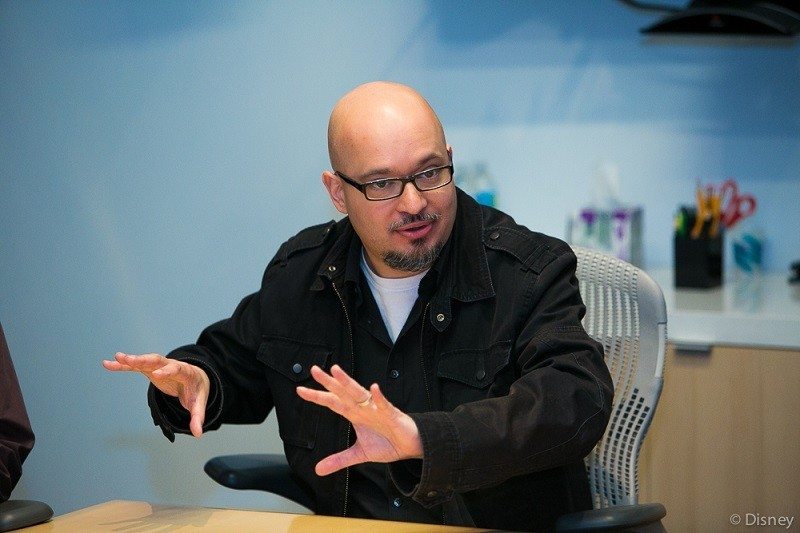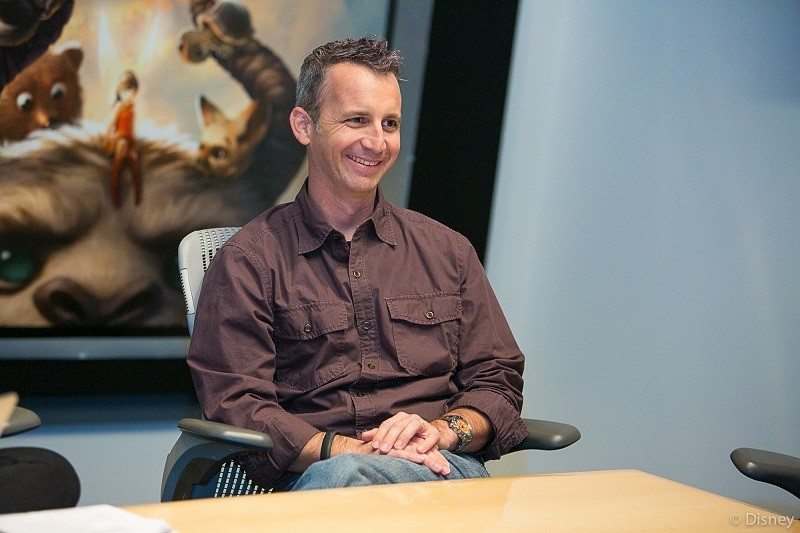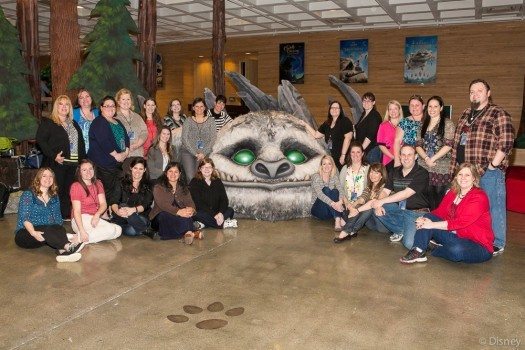Disclosure: This is part of a sponsored collaboration with Disney and the DisneyToons Studios. I received an all-expense paid trip from Disney so that I could gather and share this information. However, all experiences and opinions are always 100% my own as this post is written by me in its entirety.
Tinkerbell has been entertaining young children for ages. Pixie Hollow has grown and new fairies have joined Neverland, including a mysterious new creature, Gruff the Neverbeast. I sat down for a little Q & A with Director Steve Loter and Producer Michael “Makul” Wigert to get you the behind the scenes scoop on Tinkerbell and the Legend of the Neverbeast.

This was the first Tinkerbell movie for Director Steve Loter but the second for Producer Makul Wigert. Steve pitched this movie which was based a lot on his own daughter and family. The dna of the film comes from the roots of Steve’s family. The final movie is exactly what Steve pitched to the studio. The movie took 4 1/2 years from start to finish.
Gruff, the Neverbeast is the beast of Neverland. He’s part hippo and part many other animals, but mostly he’s part magical. The name Gruff was a temporary name as a placeholder but Gruff stuff because everyone liked it. Steve tells us that the Neverbeast was both challenging in creation but easy in imagination.
The Neverbeast came very quickly. Initially I hired a few designers to work with me to kinda’ do some drawings from a verbal idea. But pretty quickly I realized that I had this character in my head. So I knew what I wanted. So I did a drawing very early in the process and we did a painting of it and then we showed it to John Lasseter and John said, “That’s it, done, there’s your character.”
That was a wonderful thing to have approval and understand and visualize the character very early on. The challenge was following up on that because you have a beautiful 2-D painted imagine and now you have to realize that in a CG world, in a dimensional world. John kept going back to us, “Keep the appeal, keep the appeal. Look at those eyes. Go back to that drawing, go back to that drawing.” So it was an interesting process. He [Gruff] did come early and I’m very thankful for that, but it was still a challenge.

The story of Tinkerbell and the Legend of the Neverbeast came from an encounter Steve and his daughter had with a large dog while strolling through his neighborhood.
The movie was inspired by my daughter. I grew up in a household with no pets of any kind, none. No dogs, no cats, nothing. And because of having no pets around I have a fear of very large dogs. Like Irish Wolf Hound dogs, Horse Line dogs. Many years have passed and I have a family of my own. My daughter loves one thing above all else, very large dogs, and our neighborhood just has a ton of dogs. So she’ll see a neighbor walking a dog down the street and she’ll run up to the dog and she’ll throw her arms the dog in a big loving hug. And, “Okay the dog is okay to pet, phew.”
It showed me something once the fear subsided, something very important, that my daughter has a huge open heart. So I had to sit her down and we had to talk about this encounter we just had with the dog. And she would say, “Well all animals are my friends. Why wouldn’t they be? In fact, the bigger they are, the bigger the love they have to give.” And I thought that’s the story. Fawn, the animal town fairy loves animals unconditionally. She takes care of animals and she encounters a creature that can be perceived of as a monster and her open heart’s gonna’ be put to the test.
I thought, “Okay this is a message, this is a good message for Fawn, the character to have and for my daughter to learn to.” It’s beautiful to think with an open heart. To see the world through that prism, through that perspective a wonderful thing, but you also have to think with your head. You need the balance, you need the balance to have a happy life and I thought that’s exactly the story that I wanted to tell.
And that is the message Steve provided to us, using himself and his family to help develop the characters and storyline. Including their movements, and even his own parenting style.
My daughter was not just the inspiration for the initial idea through. She basically became Fawn. I looked to her for acting, for moments. There was one time when she was supposed to clean her room because friends were coming over and she just hid everything under the bed and I caught her. And so there was a whole lot of “Yeeaahhh I should have done that and I did know, but I didn’t.” And I was just– as she was saying this, I was just watching the way she would twist her hand, the way she would move her shoulders up. And I thought that’s Fawn and I literally took that scene and I worked it right in the film. When I realized that’s the connection, she is Fawn, I just kept looking to her for, for dialogue, for moments, for movement. She just became infused into the film and on top of that she is also Calista the Bunny in the film, the one that refuses to hop, she walks. Ad that’s my daughter, written just for her.
Speaking to that, I’m gonna’ expand on that a little bit. The film, though it’s about fairies and monsters, honestly is really about my family. I knew I needed to pull this story from a personal place. Not just with my daughter, Nix the Scout Fairy, the over protective Scout Fairy is me. She was a very easy character to write for because that’s the helicopter parent that I am. I am the parent that you go to the park and you’re on the monkey bars and I’m concerned not only about falling off the money bars but what germs are on the monkey bars. “No get down from there. No don’t stand on there.” And I’m that parent. So once I realized that’s my perspective on the world that maybe I’m thinking with my head too much and maybe I need to relax and think a little more with my heart and my daughter’s the opposite of that. I realized there’s my antagonist and protagonist.
But I wanna’ point out that Nix is not a villain. Nix has a point of view. She’s right about it. She’s trying to protect Pixie Hollow. She believes in this strongly. It was really important for me that it was a point of view that was real and believable and realistic. Because if she came off as a villain then I would have come off as a bad parent. So that was really important to me, but it really is my family life with some names changed to protect the innocent.
Steve mentioned that the fairy Nix is modeled after himself, but the idea of the scout fairies came as a result of his daughters gymnastics team asking to be made into fairies. And being that these scout fairies are the protectors of Neverland, one might imagine them to be boy fairies, rather than a team of girl fairies. Many films are portraying strong messages about female empowerment, it was nice to see that the scouts, the protectors, remained girl fairies.
I never thought about it. I’ve had so many strong women in my life, it just fell into place, it just made sense to me. I never gave it a second thought. This is the gymnastics team, they can do this.
The biggest challenge in this film was the character of Gruff. You’ve got this 6 foot beast stomping around and playing with the fairies of Neverland. Just imagine what a 5 inch tiny fairies looks like compared to a 6 foot long beast. The animation was a lot of work. Including the vivid imagery we see, like his green eyes and surroundings of the clouds. Steve had a strong vision for using the green color.
The color of green is eery to me. It’s a little unsettling. It makes you feel a little uneasy and that’s kind of the intention behind it. Color plays a very important part in the anatomy of the film. For animation you have the ability to make a lot of primary colors, something you wouldn’t be able to do in live action.
If you look at the beginning of the movie, with Fawn and Tink and everything is fine in Pixie Hollow there is very saturated colors and primary’s, reds and greens, and everything looks great. When Fawn encounters the beast we start pulling the colors out and it becomes a monochromatic – black and white world, it feels cold.
As their friendship begins to cement and bond we start bringing the color back in, bring in some of the greens – some of the reds. Then when the dangers comes which is signified by the storm cloud green that green touches everything. And then the whole film feels like it’s lit green. And that’s intentional. It’s an uneasy color, a slightly nauseous color. It’s meant to evoke a dangerous sensibility.
Fairies seem to have been around a very long time. I grew up with them as a child and now my children are growing up with them. In a magical place like Neverland, do fairies live forever? I am not sure if we will ever know, but we got a small hint.
Makul: The great thing about these stories is that we don’t have to answer all the questions. We can punt those questions down the road and leave them for someone else.
Steve: But we do know in the 1000 years that he [Gruff] will be hibernating, he and Fawn, will probably, well, will never see each other again.

Makul really enjoyed working with Steven on this project and is grateful to have been brought on board to make it happen.
My favorite part of the animation process is the collaboration and seeing an idea come to life through the work of a fantastic team of artists. It’s been an absolute joy seeing Steve’s idea, which started 4½ years ago, and through story boarding and design into animations, to see that coming to life through the artistry with some amazing people was absolutely a joy.
And casting for the movie was set in the mind of Makul. There were no second thoughts about it!
We knew Ginnifer Goodwin. We loved Ginnifer Goodwin and her voice, we knew was going to be Fawn. That was easy for us. We had a conversation about then who would be playing against her and we wanted somebody who could contrast the joyful bubbly nature that was Fawn. And so for Nix we then discovered Rosario [Dawson].
When we brought Rosario up she just has this cool voice. And you can hear her passion and her belief in what she feels is right and that contrast we thought was really beautiful and really nice. And working with both of them was just an absolute joy.
And we’ve been blessed on this project having a terrific cast. With Ginnifer, with Rosario and our Mae Whitman and with rest of the cast have all been absolutely fantastic to work with.
Tinkerbell and the Legend of the Neverbeast is available for pre-order now and is scheduled for release on March 3rd. The latest Tinkerbell movie is a definite must add to the movie collection for the entire family.
Get social online with me and all the bloggers that went behind the scenes to bring you the scoop on Tinkerbell, Fawn and Gruff using the hashtag #NeverbeastBloggers learn more and interact with us on Facebook, Twitter and Instagram. All photos courtesy of Disney.



